The US and the UK Master’s Part / Chapter-wise Dissertation Writing Service

Then You’ve Certainly Reached the Right place
Marketing Tool
Introduction
The Macro, meso and micro business environment of Tesco have been critically analysed in this particular report. This report is analysed using strategic market evaluation tools such as PESTEL, Five Force analysis of Posters, the SWOT analysis and the value chain analysis.
Tesco – Company Overview
Tesco is considered to be one of the largest food retailers and in the year 2009 it has made a profit of revenue of £54 billion with its work force of 470000 people. Tesco and other major market player shown below (Euromonitor, 2010)
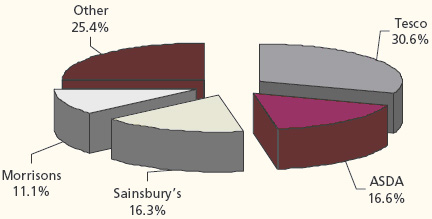
Fig 1: Share of Leading Players in UK Food Retail Market
PESTEL Analysis
PESTEL analysis is used of analyse and identify the dynamic operation of Tesco and it impact into the field of marketing.
Political
There has always been a free flow of foreign trade with China and all barriers were removed encouraging Companies from the West which also includes Tesco so as to make a profitable business with the 1.3 billion people (Straits Times, 2010). Joint ventures were made in china for developing shopping malls in the year 2009 (Tesco, 2009).
This literature also presents information of promotions which was in full support by the government for its free trading bloc is also presented in this literature (Lynch, 2003). Promotion of trade was encouraged and made interesting in European Union. This has provided Tesco with the platform and the opportunity needed to expand its retail network.
Economic
It is always a matter of concern for Tesco to concentrate more on the Economic factors as this retails more with the buying behaviour of its customers. This has resulted in the steady increase in employment and have slashed down unemployment to a greater extent which in turn has built it more confidence in the current financial year 2009 (Euro monitor, 2010). There is still more to go and there is more of financial crisis where people tend to spend very little on premium products, encompassing ready prepared meals and organics which tends to have an adverse effect on both margins and sales (Key note 2010)
Recession has its own optimistic way of approach where customer do not tend to eat out but tend to buy grocery which in turn will increase the output of grocery retailers like Tesco (Guardian, 2010).
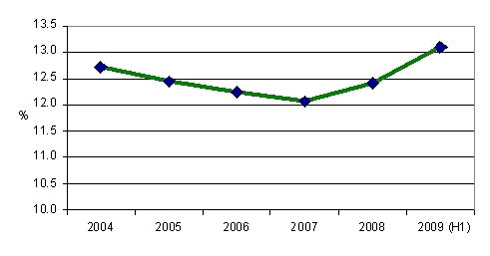
Fig 2: UK Spending on Food as % of Overall Consumer Spending 2004 to 2008
The GDP graph in detail has brought to light the economic downturn since 1989 (Mintel, 2009):
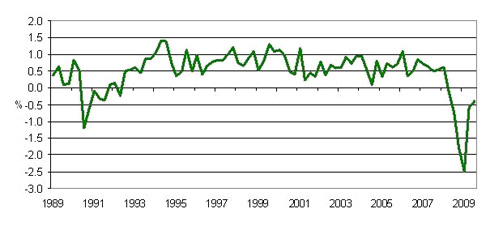
Fig 3: UK GDP Growth 1989-2009
Social
With the analysis done on the whole of UK population there seems to be more of Retired people that children (Herald Scotland, 2010). It is discouraging scenario for the food retailers since the ageing population tends be more and they eat less.
Everybody has become health conscious and the attitude towards food has drastically changes. There is always increased demand for organic food and Tesco has incorporated the research work. The possibility of payment by check or cash was first made available by Tesco.
Technological
Technology is the key macro-environmental variable which directly has an influence with the process of operation in the food supply chain. (Office for National Statistics, 2010).
Introduction of loyalty program that discourages customer not to switch to its competitors (Sun, 2009).
Mobile phone is used to buy selected wine directly using the recently developed mobile application called Cortexica vision Systems, adopted by Tesco since 2009 ( Tomlinson & Evans, 2010).
A survey by Keynote 2010 has showed that 70 % of the country’s overall population uses internet and this amounts to about 15.5 million people.
Environmental
Concentration of Tesco on the environmental factor has helped Tesco earn credibility and help build a corporate social responsibility image
Dairy products, orange juice and potatoes have carbon food print data as a part of Tesco and also aimed at getting on other non food items by 2010 (Tesco 2010)
Green Living Scheme is also a part of Tesco which was introduced (yuthas,2009)
Rewards are also given for consumers who use recycling mobile phones, reusing bags, aluminium cans and those who prefer bagless delivery through Tesco’s green club card points (Tesco 2009) (Datamonitor,2010)
Legal
The VAT percentage has risen up to 20 % on the prediction on government to finance on huge deficit (HM Treasury 2010).
There was a increase in the minimum wage to about 15.5 % which was found by the analysis that was done by the Low Pay Commission Report (National Minimum Wage, 2009).
Porter’s Five Forces Analysis
According to (Porter, 1985) the effective source of competitive advantage is determined by detailed analysis that is done on the structure of the industry.
Threat of substitute products and services
Substitutes in the retail market of grocery is always considerably low for food items and medium-high for non-food items .
Small chain of convenience stores are considered to be the substitutes for major food retailers in the retail market and are not to be considered as threats by supermarket like Tesco where products are sold at a considerably low price ( Financial Times 2009).
New competitors
There is not much new competition in the food retail industry.
Huge capital is needed to beat the competitors and create a valued brand name. (Mintel, 2010).
Competitive rivalry
Competition is intense in this sector.
Tesco, Asda, Sainsbury’s, Morrisons and Waitrose: among these Asda has gained increase in terms of the market share to 16.8% from 16.6% , Sainsbury’s has improved from 15.8% to 16.1% and Morrisons has gained from 11.3% to 11.6% (Euromonitor, 2010).
Market growth rate is inversely proportional to competitive rivalry.
Bargaining power
Buyer
It is fairly high in terms of the buyer.
As the cost for switching is low, buyers can easily change brands.
Low prices attract customers.
Supplier
This is pretty low
Suppliers do not want to loose major consumer brands.
SWOT Analysis.
Strengths
Tesco is third largest in the food industry (Datamonitor, 2010) with 30.7% share (Euro monitor, 2010).
It is financially strong with a £54 billion turnoveand great performance efficacies ( Fame, 2010):
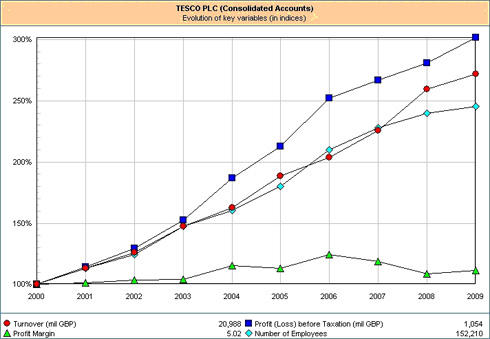
Fig 4: Tesco – Yearly Growth in Key Performance Indicators
- Affordability is the key and online presence boosts accessibility (Tesco, 2010).
- Customer retention through club cards.
Weaknesses
- Product recalls have tarnished image and hence the last year was bad
- Localised within the UK with 75% customer base and hence not geographically diversified.
Opportunities
- Geographic diversification is a great scope for tesco (Mintel, 2010).
- Growing popularity is a plus (Guardian, 2010).
- Global expansion esp. To Indian market in franchise with TATA group (Daily Mail, 2010).
- General rise in the food retailing sector is advantageous (Euromonitor, 2010).
Threats
- UK’s economy hit due to the recession is a big threat to the UK based companies in general.
- Unemployment translates to income decline and this translates in the market.
- Rising competition makes it impossible to hold and retain market share.
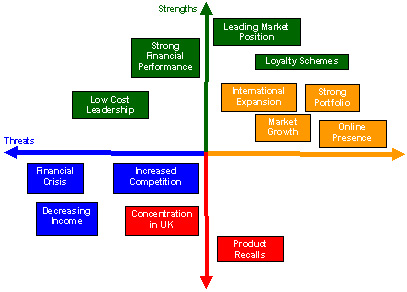
Fig 5: Tesco SWOT Analysis
Value Chain Analysis
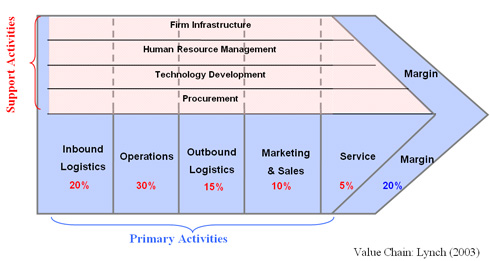
Fig 6: Value Addition in Value Chain of Tesco
Inbound Logistics
Cost leadership is the strategy combined with lean and inbound function. Drawing upon market position is used to achieve cost effectiveness Abeysinghe (2010). Large scale production helps achieve advantage by economies of scale. Upgrading production and distribution strategies to achieve maximum profits.
Operations Management
IT systems have been effectively employed to generate revenue. £76 million was invested in the Tesco Digital program (Tesco, 2010) this has generated £550 million in profits.
Outbound Logistics
Online and offline supremacy helps gain leadership. Maximum exposure to the customer is acheived
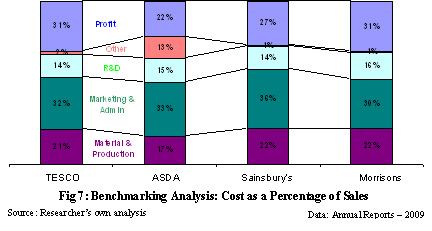
Fig 7: Benchmarking Analysis
Conclusion
Cost differentiation and strategic positioning with the help of internet presence and information technology, customer loyalty retention through club card schemes agile supply chain management have all effectively contributed to the success of the company and added futuristic value to its services.

Researchers to mentor-We write your Assignments & Dissertation
With our team of researchers & Statisticians - Tutors India guarantees your grade & acceptance!
Our servicesReferences
Abeysinghe, T. (2010), Roaring tigers, rising dragon, Straits Times (Singapore), February 2, 2010. Retrieved online from website http://www.fas.nus.edu.sg/ecs/scape/doc/ST-NUS-Econ-Series-02Feb10.pdf
Audretsch, D. B. (1995), Innovation and Industry Evolution, (Cambridge: MIT Press) BBC (2009), Czech, Greek presidents support Turkey's EU bid, BBC Monitoring Europe, December 2, 2009. Available at can’t find link, post link here [accessed 07/07/2010] Daily Mail (18 Jan 2010), “Tesco starts Pounds 1bn price war”, Daily Mail, Jan 18, 2010. 7
Datamonitor (2010), ‘Company Profile – Tesco’, Datamonitor Europe, 2010, Ref Code: 1674
DunnHumby (1996), Databases in direct marketing, IDM lecture presented at Bristol Business School, Bristol, November 21, 1996.
Euromonitor (2010), Industry Profile – Food retailing, Euromonitor International, 2010
Fame (2010), Annual Reports Analysis – Tesco plc, FAME International
Herald Scotland (2005), Baby boom gone bust, Policies needed to tackle worryingly low birthrate’, Herald Scotland, November 11, 2005. Retrieved online from website http://www.heraldscotland.com/sport/spl/aberdeen/baby-boom-gone-bust-policies-needed-to-tackle-worryingly-low-birthrate-1.37681
HM Treasury, (2010), Evidence on the UK Economic Cycle, July 2010 [cant find] but is it the following? HM Treasury, (2008), ‘Evidence on the economic cycle’, HM Treasury, Retrieved online from website http://news.bbc.co.uk/1/shared/bsp/hi/pdfs/24_11_08_pbr_economiccycle.pdf
Keynote (2010), Keynote Report on Food Retail Industry, Keynote International [cant find. Wrong date. Need to provide link]
King, I. (2009), Tesco shows its claws, Sun, Jan 18, 2009. p.42
Lynch, R. (2006), Corporate Strategy (4th ed.) (Harlow: Pearson Education Limited)
Mintel (2009), Food Retail Industry – Including Online, Mintel Research
National Minimum Wage (2009), Low Pay Commission Report 2009, National Minimum Wage. Retrieved online from website http://www.lowpay.gov.uk/lowpay/report/pdf/7997-BERR-Low%20Pay%20Commission-WEB.pdf
Office for National Statistics (2009), Internet Access Households and Individuals’, Office for National Statistics, Retrieved online from website Available at http://www.statistics.gov.uk/pdfdir/iahi0809.pdf
Porter, M. (1985), Competitive Advantage: Creating and Sustaining Superior Performance, (Location: The Free Press)
Poulter, S. (2009), Debt problems piling up for younger generation, Daily Mail, Nov 14, 2009
Shales, A. (2009), An unpalatable attitude towards food, Financial Times, Oct 22, p.19
Tesco (2009), Corporate Responsibility Report, Tesco. Retrieved online from website http://www.investis.com/plc/cr09/crr09.pdf
Tesco (2010), Annual Report and Review 2010, Tesco. Retrieved online from website http://ar2010.tescoplc.com/en/downloads.aspx
Tomlinson, H. & Evans, R. (2010), Tesco stocks up on inside knowledge of shoppers’ lives, Guardian, Retrieved online from website http://www.guardian.co.uk/business/2005/sep/20/freedomofinformation.supermarkets
Turban, E., Rainer, R.K., & Potter, R.E. (2001), Introduction to Information Technology, (Chichester: Wiley)
Wood, D. (2009) Are We Cooked Yet? Treasury & Risk Management, 15(6), pp.1424
Yuthas, K., (2009), Inputting the Environment: Reconsidering the Environmental Information
Matrix, Journal of Information Systems, 19(2), Fall 2005, 105-109 [2 dates do not tally – 2009 or 2005?

Full Fledged Academic Writing & Editing services
Original and high-standard Content
Plagiarism free document
Fully referenced with high quality peer reviewed journals & textbooks
On-time delivery
Unlimited Revisions
On call /in-person brainstorming session
More From TutorsIndia
Coursework Index Dissertation Index Dissertation Proposal Research Methodologies Literature Review Manuscript DevelopmentREQUEST REMOVAL


